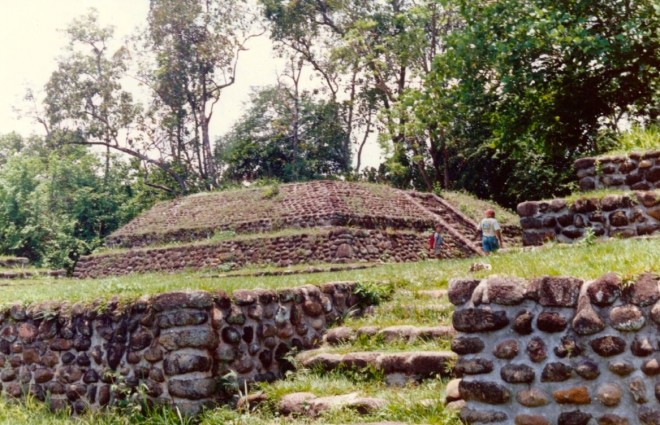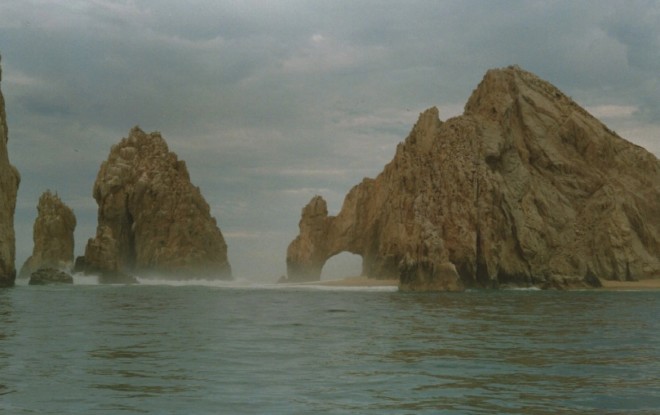At a Crossroads
/We waited. For four months we waited in Golfito, Costa Rica, and in France. We waited for Michel to return to the boat following his medical emergency. It was a Panic in Panama when he was urgently evacuated from the canal zone—having been overcome by septicemia—just as the Americans were about to launch the Invasion of Panama in November 1989. The boys and I were alone on Cowabunga.
Shortly after Michel's evacuation, the children and I transited the Panama Canal with a hired captain, arriving in Golfito just over the border from Panama, in early November just as the invasion was launched. We were out of harm's way. We settled into a routine of school, and regular Ham radio sessions to stay apprised of Michel's condition back in France. It was touch-and-go for him and took several weeks in the hospital to stabilize him. Then we decided to have his implantable defibrillator removed once and for all. Michel was finally able to come back to the boat four months later in March 1990. At this juncture in our travels, and our life on Cowabunga, we had reached a crossroads.
It was time to take a hard look at things. For the past three or four years, Michel's health issues dogged us: a hernia, the episode of sudden death, implanting a defibrillator, widespread infection…we were spent. Sean and Brendan were now 11 and 8, and money was beginning to run low—again. Although homeschooling was going quite well onboard—and while the experience was enriching for all of us—I recognized my shortcomings as a teacher, and I seriously doubted that I could, or wanted, to continue in this role. Also, at 42 ft., Cowabunga was beginning to get small for two growing boys, and for better or worse, Sean and Brendan would have to experience some of the "real" world along with some of the things that were obvious to other kids in school: waiting in line, school assignment instructions, school activities, babysitters, time constraints…
We didn't have a definite plan, just a rough draft. Targeting an eventual landfall in Bodega Bay, just north of San Francisco where my parents lived, seemed like an immediate, sensible, and attainable goal. Bodega Bay had the advantage of being a well-protected harbor, near family, the possibility of finding jobs in the area, and putting the kids in school. We had been in a "start over–return to civilization" mode several times by now over the past few years, so we knew the routine. Thus we prepared to head up the coast of Central America and Mexico, planning to re-enter the U.S. in San Diego, having last been in the U.S. in Key West two years earlier. But it would be a long haul up this coast, dueling with the infamous summer headwinds and the fog.
The sage advice in sailing circles is that in order to head up the Pacific Coast to either Los Angeles or San Francisco in the spring or summer, the best tactic is to head out west to the open ocean to Hawaii and then make one big long angled reach back to California. That way one could avoid tedious tacking up the whole length of the coast. However, we decided to disregard this widely-accepted advice with the idea of making as many short day-sail trips as possible, in order to visit as much of the coast and picturesque anchorages that we could. This plan would also hopefully make it easier on Michel physically since he was still rather weak, and minimize the risk of being out in the open ocean should something happen to him. I had regretted not being able to visit some of the interior of Costa Rica, and some of their famous national parks and natural preserves, but after four months here already, time and looming weather constraints of the impending summertime hurricane season in these parts pressed us to move onward, and we wanted to put a lot of these bitter times behind us.
So progressively we sauntered up along the green tropical coast and white sandy beaches of Coast Rica. The landscape soon transitioned into the striking coastline of Nicaragua's sudden dormant volcanos that jabbed the sky as they jutted from the plains, all while we maintained a healthy respect for the possible advent of the fabled sudden violent and erratic Papagayo winds. Off the coast of El Salvador we had an unsettling encounter with a small gunboat patrol, manned by very young men in ragged street clothes, brandishing assault weapons. They insisted on boarding us for an inspection. We refused. Governments were unsettled in these parts in the 80s and things could have turned ugly in a snap. We had heard and read stories of such "inspections" where drugs were planted onboard then "found" and all the surreal terror that ensued. We told them we were just a family heading home, and quickly summoned Sean and Brendan to make an appearance on deck. This seemed to appease these military "wannabees" and they quickly changed their tune, waving us on our way.
The coast of Guatemala quickly slid by and we made our first official port entry in Puerto Madero, Mexico, just over the Guatemalan border. Having grown up in Southern California, so close to Mexico, yet never having the opportunity to venture this far south, I nevertheless felt like I was almost home once we crossed into Mexican territory. Since the politics of Mexico at the time weren't as volatile as that of Nicaragua, El Salvador, or Guatemala, we knew we could linger in Mexico a bit more easily, so we did. In Puerto Madero we met a young man on a neighboring boat who told us about some obscure Mayan ruins inland in nearby Tapachula. The next day we all boarded a bus in town and headed out that way. All we had were a few vague, hearsay indications of a field where some covered ruins, overtaken by vegetation, may be hidden from plain view. Once in Tapachula, someone pointed us in the direction of a small pick-up "group taxi" that would take us in the general direction, outside of town. Dropped off at a nondescript dirt crossroads, the driver told us to head down an adjacent dirt path. It seemed as if we were going to someone's hut. Down a muddy trail, into the overgrown bush, past peasant dwellings, and finally emerging into a clearing, there we were, suddenly amongst Easter Island-type statues and stones, hailing distinct pyramid-shaped peaks, covered with earth and vegetation, some haphazardly excavated, most not, and a few moss-covered stone steps that appeared here and there.
Onward we pushed, passed the infamous Gulf of Tehuantepec, also with a reputation for sudden violent winds as we targeted Acapulco. Then one late afternoon as the sun was angling low on the Pacific horizon, we weren't far off the coast from Huatulco when we spied some interesting modern-designed buildings on the coast. We pulled out the binoculars for a closer look. It was undoubtedly a vacation resort of some sort. Then we noticed a high-powered zodiac speeding toward us. A couple of young, tan, athletic "beach-type" looking men were onboard and they came alongside, hailing us with big smiles, and speaking French. They were from the Club Med of Huatulco, (thus solving the mystery of the buildings), and from the shore they could see that we flew a French flag in our rigging. They beckoned us to join them, and join in on some fun. We had never been to a Club Med, so we changed course, anchored in their bay, and spent a week as special invited guests in this sort of make-believe world of fun and games. It wasn't much our style or usual idea of a vacation, but hey, we were invited, and we did end up enjoying this spontaneous occasion. The staff bid us partake of the meals, the shows, the activities, and as extra bonuses they filled our coffers with French bread, pastries, and all kinds of food. Sean and Brendan had a great time participating in their games, water sports, and evening shows. The whole staff was extremely generous and hospitable.
While there we came across three Australian sailors who had the curious mission of repairing and reconstructing the America's Cup boat, the Stars and Stripes, a catamaran that won the 1988 challenge against New Zealand in San Diego. A prosperous Mexican yachtsman had purchased the boat and relocated it to a back bay of Huatulco, where these three were reconstructing the boat amongst quite a setup of containers, rigging equipment, apparatuses, a sewing machine, and all manner of precision tools in a base station they dubbed The Kangaroo Yacht Club. The 1988 Stars and Stripes had been the first such
revolutionary twist in America's Cup design as a catamaran with a winged mast or hard sail. We spent a few hours with them on at least two occasions as they gave us an extensive tour of the boat, and even generously repaired our genoa sail that sustained some damage from a hefty gust in the Gulf of Tehuantepec.
Bidding adieu to all our newfound friends and a veritable week of fantasy and relaxation, we continued northbound with some quick stops in Acapulco, Bahia de Navidad, and Puerto Vallarta. My childhood terra firma of California seemed close now as we traversed the Sea of Cortez to Cabo San Lucas, Baja California. Cementing that impression on my brain was a distinct memory of suddenly realizing that we had crossed a threshold. The constant warm and comfortable temperature of tropical ocean water had been our familiar environment for all these years from Africa to South America, Florida, the Caribbean and Central America. We sailed in it, used it, swam in it, and well, just lived with it. It was a given. I had the sudden realization that I had taken all that for granted and it was part of a bygone era, when here, off the coast of Cabo San Lucas, in the coastal Pacific Ocean's cold California Current, I doused myself with a bucket of water, cleaning up at the end of the day as was our customary routine. My lungs seized up with the icy surprise! Indeed, we weren't in Kansas anymore! This was jarring, and consequently today, 25 years later, I still refuse to bathe in the cold Pacific Ocean that is 30 minutes from our home. I know there is something more accommodating elsewhere!
Making progress northbound along the desert landscaped, cactus pock-marked coast of Baja, we were struck by the bountiful sea life that kept popping up around us. Thanks to Sean's now well-honed fishing techniques, he had good luck catching some bonita and dorado, while whales and seals would regularly break the surface. On one occasion a whale shark lingered nearby and a huge sea turtle or two would poke around every once in a while.
An oft-told tale recounted amongst sailors and in sailing lore tells of a sunset phenomenon at sea known as the Green Flash. Conditions have to be just right with a clear horizon, a calm flat sea, and just the right amount of a glorious red glow as the sun dips below the water line. Then, all of sudden, at the very second of the disappearnce of the last yellow crescent of sun, a barely discernible "poof!" of a tiny green mushroom cloud leaps up, and voilà, all four of us witnessed this elusive, but very real Green Flash—not once but at least twice—off the coast of Mexico. Like our vision of the mirage some years earlier, we can vouch that the Green Flash is not a myth, but a legendary vision.
Onward past Turtle Bay, Isla Cedra, Isla San Martin, Ensenada, and Tijuana we trekked, finally making our U.S. landfall in San Diego, just days before the Fourth of July, 1990. It was bittersweet to arrive back in the States, back in California. I was somewhat relieved to be in a safer place given our current hobbled status, but sad at the same time. We didn't talk about it, but we knew that the route before us was most likely the last stretch—for a while—of our 10 year journey. We officially entered the country, completed the customs and immigration formalities, and then I phoned "home."










